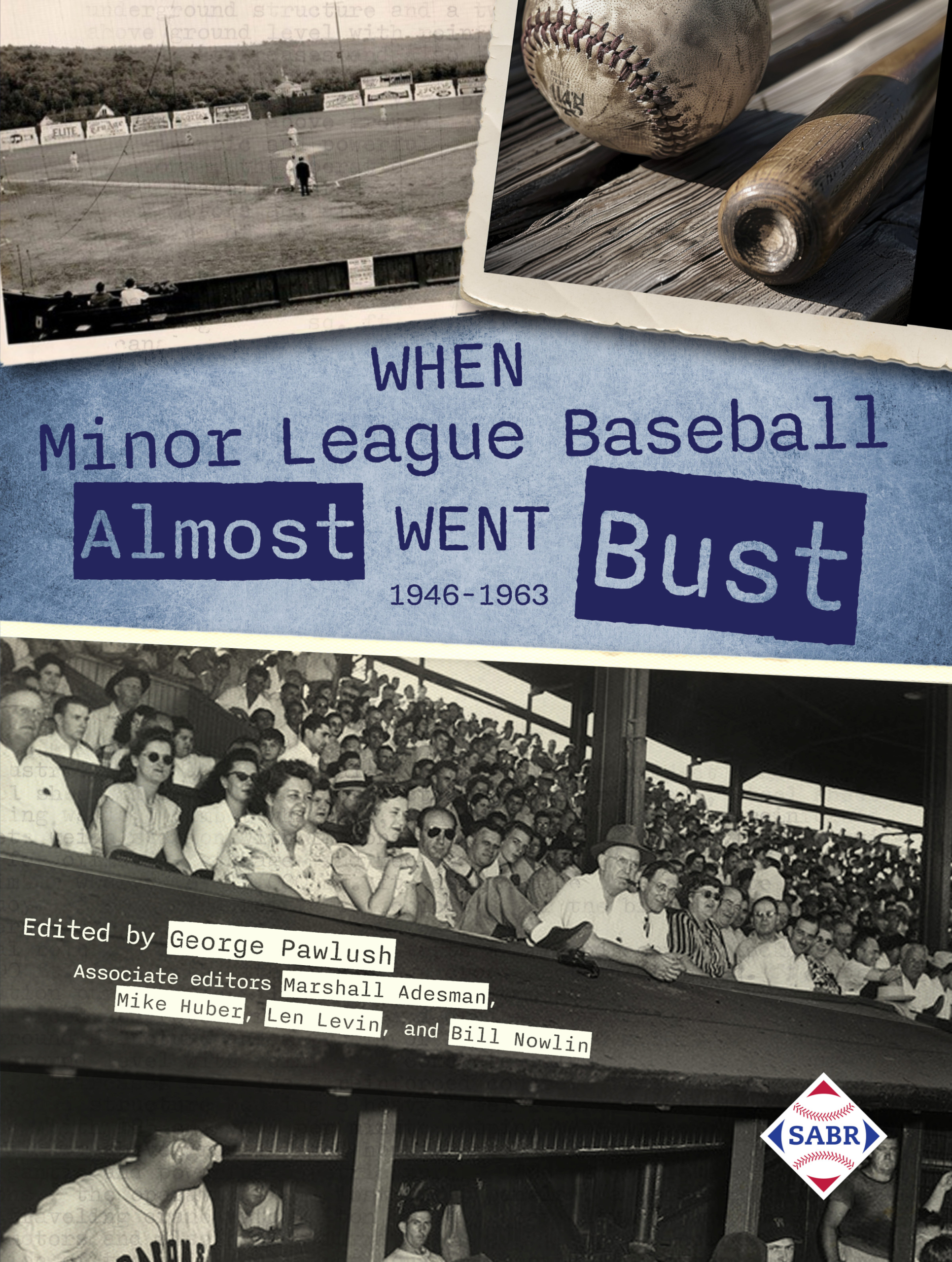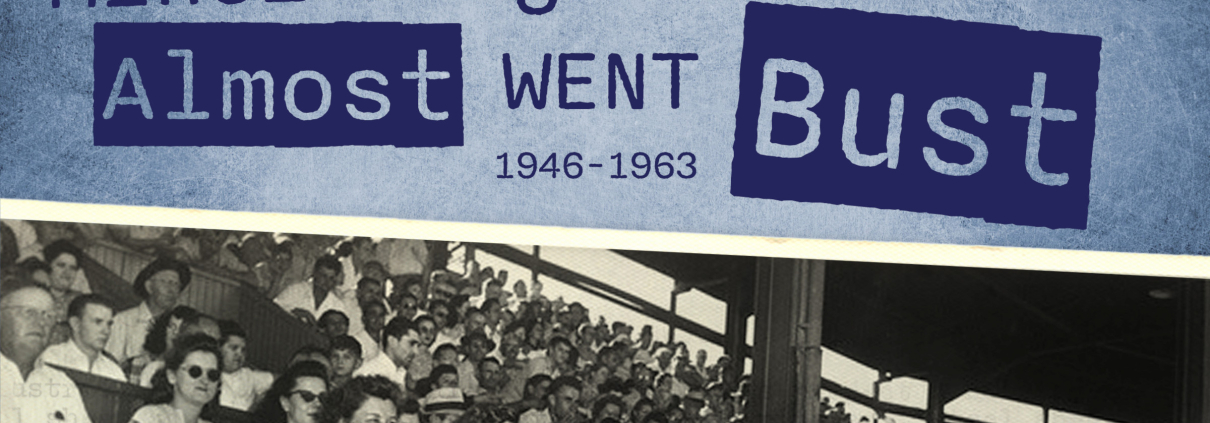The Enchanted 1950 Season for the Olean Oilers
This article was written by Joe Marren
This article was published in When Minor League Baseball Almost Went Bust: 1946-1963
 Olean, New York, sits in a plateau in the foothills of the Allegheny Mountains. It is surrounded by rolling hills whose forests burst into a rainbow of color in autumn, mimic crystal and silver spires in winter, explode with new life in the spring, and cover the land with cooling shade in summer. Residents and Chamber of Commerce types alike call it the heart of the Enchanted Mountains.
Olean, New York, sits in a plateau in the foothills of the Allegheny Mountains. It is surrounded by rolling hills whose forests burst into a rainbow of color in autumn, mimic crystal and silver spires in winter, explode with new life in the spring, and cover the land with cooling shade in summer. Residents and Chamber of Commerce types alike call it the heart of the Enchanted Mountains.
If enchanted means more than Disney movies—if it transcends celluloid life—then Olean can lay claim to some sports enchantment. But as the late Commissioner A. Bartlett Giamatti once said, baseball is also designed to break your heart. And Olean has had its share of that, too.
Yet Olean did rejoice from time to time.1 In the early 1950s, the unaffiliated Olean Oilers of the Class-D PONY League won the 1950 Governor’s Cup. It was the first club without any major-league ties to win the league title. Close behind in sports glory for the region, the St. Bonaventure University Brown Indians2 men’s basketball team finished with a 17-5 record in 1949-50 and guard Ken Murray was named a 1950 Associated Press Honorable Mention All-American. The basketball team was ranked as high as 17th in the AP poll during the 1950-51 season and finished 19-6, barely losing an NIT quarterfinal game to St. John’s University, 60-58.3
BACKGROUND TO 1950
Prior to all that, the good times started rolling near the end of the nineteenth century and continued up to about the mid-twentieth, when impersonal math subtracted revenue loss from population loss to equal a franchise lost at the end of the 1962 season. Chronology tells the story:
Immediately west of the City of Olean are the Town and Village of Allegany, and within that neighborhood is St. Bonaventure University. At the back of campus, near the Allegheny River as it meanders its way to join the Monongahela in Pittsburgh to form the Ohio River that flows into the Mississippi, is the McGraw-Jennings Athletic Field. It’s named for Baseball Hall of Famers John McGraw and Hugh Jennings, who played and coached at St. Bonaventure in the 1890s. Legend has it that they invented the bunt in what is today’s Butler Gym on campus. That’s not true, but any Bona grad will insist there is a grain of truth in it since McGraw and Jennings turned the bunt into the high-bounce Baltimore chop that bedevils infielders.
The 17-year-old McGraw left his home in Truxton, New York (about 26 miles south of Syracuse), for Olean in 1890 with a contract to play ball for Olean in the unaffiliated New York-Pennsylvania League. It didn’t go well and he was released by the team after six games and numerous errors playing third base. To flesh that out for context, in 1890 the New York-Pennsylvania League was not affiliated with Organized Baseball. But times change and in 1891 the New York-Pennsylvania League was considered a legitimate minor league (its only year as such, according to The Encyclopedia of Minor League Baseball)4 and Olean finished 42-55, 19 A games behind league champion Erie, Pennsylvania.
That was Olean’s first brush with the minors, but not its last. In 1905 the Olean Refiners5 of the Class-D Interstate League finished 816 games behind the Coudersport Giants.6 In 1906 the Refiners finished seventh in the eight-team league, 18 games behind the Erie Sailors. Olean disbanded on July 18, 1907, with a record of 12-35. Anew team, the Olean Candidates, played to a 15-2 record and were in first place before the league itself disbanded on June 5,1908.
A revised Interstate League emerged in 1914 and the new Olean Refiners finished that Class-D season with a 43-53 record, 1414 games behind the Jamestown Giants in the six-team league. If that wasn’t disappointment enough, there was more set for 1915 when the Olean White Sox (52-30) finished two games behind the Wellsville Rainmakers (54-32).7 However, Olean refused to participate in the postseason playoffs due to a dispute about the won-lost record of the Jamestown Rabbits, which had disbanded on August 14, 1915. Olean argued that Jamestown’s record of 28-42 should not include any victories against Olean and, therefore, Olean should have won both halves of the season. But the league refused to change the records and Wellsville won the league title by default.8 And that set the stage for a disastrous 1916 season, when Olean finished last in the then eight-team league and disbanded on July 12 with a record of 16-25. As was common then, few minor-league teams were affiliated with major-league franchises. But the next time Olean was represented in Organized Baseball, it was with the 1939 PONY League, with teams scattered across New York, Pennsylvania, and Ontario, and it was a Class-D farm team of the Brooklyn Dodgers.9
The Olean Oilers (a throwback name to the Refiners days) had the best record in the league’s inaugural 1939 season, finishing 65-38 in the six-team circuit, five games ahead of the Hamilton Red Wings, a farm team of the St. Louis Cardinals. In the playoffs, Hamilton beat the Batavia Clippers, three games to two, and the Oilers beat Bradford (Boston Bees), three games to one. The Oilers took the title that year after beating Hamilton four games to two. The 1940 season proved to be almost a mirror image, with Olean finishing on top during the regular season with a 65-39 record, eight games ahead of the Clippers,10 which Olean beat in the postseason series, four games to two.
After that, however, Olean was usually near the bottom of the standings, both in won-lost records and attendance. For example, Olean finished fifth in the six-team league in 1941 (48-61) and last in 1943 (43-66), when it was also last in attendance with 23,288 fans going to games at Bradner Stadium.11 Following along, the team was last in the standings in what was then an eight-team league in 1945 (40-86) and also last in attendance (24,780).
Things initially improved after World War II, as the team gradually got better and would finish as high as third in the standings, though it usually lost in the postseason playoff series;12 attendance also picked up to third or fourth in the league. But the team slipped in 1948, its last year with Brooklyn, as the Oilers fell to 60-66, seventh in the standings and also in attendance.13
The woeful St. Louis Browns (53-101) were the parent team in 1949 and the Oilers shared in the misery when they finished last at 39-86 (40% games behind the Bradford Blue Wings14) and in attendance (40,264).15 There were 56 players who suited up at one time or another for the Oilers in 1949. The independent team of 1950 had 28 players16 and was managed by Len Schulte,17 who also made the league all-star team at third base. Infielder Chuck Harmon,18 infielder Gerald Maley and outfielder Milton Neal were the holdovers from ‘49. Right-handed pitcher Bill Gates also suited up for 18 games with the Oilers in 1949 and 12 with Lockport that season. Harmon led the team with a .374 batting average, and the league in hits (206) and RBIs (139); he was selected to the PONY League All-Star Team19 as a second baseman. Left-hander Edwin Williams was Olean’s best pitcher with a 12-3 record and a 3.41 ERA.
1950 POSTSEASON
The impressive turnaround from the ‘49 season was highlighted by a second-place finish (71-54), 10% games behind the Hornell Dodgers (81-43). The playoff round had Olean face the third-place Hamilton Cardinals (St. Louis) with its 68-57 record, and top-seeded Hornell playing fourth-seed Bradford Phillies (Philadelphia) with their 63-62 record.
Hamilton had 1950 All-Star catcher Joseph Ossola20 and right-handed pitcher Thomas Keating.21 Olean countered with its own all-stars of Harmon, player-manager Schulte and lefty pitcher Williams to win the series that September, four games to two.
One of the more dramatic games was the very first one of the series, an 8-7 Olean win before 1,036 fans in Bradner Stadium. The Oilers, trailing 7-1, scored six runs in the seventh inning to tie the game. In the ninth inning, Olean’s Carroll Anstaett singled and manager Schulte sent in Bill Gazdik to run for him. Johnny Gates’ sacrifice moved Gazdik to second. Keating then faced the top of the order and he intentionally walked Bill “Bud” Dowling to face George Rodems, who struck out. Henry Redmond came to bat for the Oilers, and his grounder was mishandled by Hamilton shortstop Bob Rooney. As the ball rolled into center field, Gazdik scored to give Olean the win.22
Olean outscored the Cardinals in the series 45-35, clinching the series with a 3-1 win on September 11. Hornell had already swept Bradford in four games, so the Olean Times Herald on September 12 boasted with no shortage of civic pride:23
Bring on the pennant winning Hornell Dodgers, their .400 batting champion,24 and their 23-game winner.25
The Olean Oilers are ready.
Monday night they eliminated the Hamilton Cardinals in the semi-final series of the PONY League playoffs for the Governor’s Cup as they turned back the Canadian club, 3-1, as Bill Gazdik26 turned in the best pitching performance of the series for the Oilers.
Despite Olean’s bravado, Hornell had won the regular season meetings, 13 games to 5, and entered the series with confidence. The feeling was that Hornell’s pitching would stymie Olean’s batting.
That proved to be misplaced optimism as Olean took the first game, but it wasn’t easy. Olean had a 2-0 lead at the end of two innings on Stan Anderson’s two-run homer to right. The Oilers added another run in the third but Hornell scored six in the bottom of the third off Williams to take a 6-3 lead. Cas lasillo’s three-run homer was enough for Schulte to put Gates on the mound in relief.
Hornell pitcher Ralph Butler was pulled in the fifth inning for Ed Moore after giving up three runs that tied the score at 6-6.
The Oilers pulled ahead in the seventh inning, 8-6, when Anderson hit a triple along the left-field foul line that scored Harmon and Gene Haering.
Gates may have been tiring by the eighth inning when he gave up two singles and a walk that loaded the bases with no outs. Gazdik was brought in and got pinch-hitter Ralph Cascella to pop up to third for the first out. Dominic “Muzzy” Bertocci walked, however, which brought in a run and made the score 8-7. But Gazdik left the bases loaded as Don Kattus popped up to first and infielder Don Zimmer swung and missed on a 3-and-2 pitch. Neither team scored in the ninth and Olean took the opener with eight runs on 12 hits.
Hornell took the second game, 12-3, to even the series. But the Oilers won the next two games, 4-3 and 6-3, thanks to its pitching, according to the September 18 Olean Times Herald, for a three-games-to-one series lead.
The Warren Times Mirror reported that Hornell won, 6-5, at home on September 18 for its second win of the series, when player/manager Andrew “Doc” Alexson hit a grand slam. The Dodgers evened the series at 3-3 on September 19 with a 9-3 win:27
Hornell overhauled Olean in the Governor’s Cup race with a 9-3 triumph at Olean last night. Murray McDermid’s pitching and a six-run third inning splurge sewed up the Dodgers’ third win. A home run by Doc Alexson and a two-run triple by Ralph Cascella, both in the eighth inning, aided the Hornell dividend.
The seventh and deciding game was never comfortable for either team. Olean scored the first two runs in the fifth inning, but Hornell came back to tie it up in the sixth off a deep single to center by Zimmer that scored Gil Shirk and Bertocci.
Olean took a 4-2 lead in the eighth when Henry Redmond walked and Neal went in to run for him. Harmon and Schulte then each reached base on errors by the Dodgers’ Leo Tuite and Henry Franklin. With the bases loaded and no outs, Haering hit a deep fly to left field that scored Neal. Anderson forced Harmon at third, but Anstaett’s single to left scored Schulte from second.28 But there was more drama to come:29
The Hornell ninth was a humdinger. Tuite led off with a single through the box and lasillo struck out. Cascella then doubled with Tuite holding at third. Gates was lifted in favor of Gazdik. He hit the first man he faced, pinch hitter Matt Flythe and the bases were loaded.
Gazdik walked Bertocci to force in Hornell’s third run before Neal popped into the double play to [George] Rodems ending the game and the PONY League playoffs for 1950.
The attempted squeeze play backfired and Olean won a title as an independent team, 4-3, the first team to do so in the PONY League.
CONCLUSION
As the Olean Times Herald put it, “The runner-up Olean Oilers, rated the darkest of horses in their independent venture before the season opened, reaped sweet revenge in copping the Governor’s Cup.”30
An independent Olean team would again meet Hornell (still with the Dodgers) in the 1951 title series, but this time Hornell won, four games to three.31
Olean found a parent club but lost its Oilers nickname in the 1952 and 1953 seasons. The Olean Yankees finished third and fifth respectively those seasons. The Olean Giants in 1954 did even worse, finishing seventh in an eight-team league.
By 1955 the team was independent again and finished last in the league. Things rebounded in 1956 when Olean reclaimed the Oilers name and finished in third place. That year the Oilers were affiliated with the Philadelphia Phillies and made it to the Governor’s Cup, but lost to the Wellsville Braves (Milwaukee), three games to two.
The PONY League became the New York-Penn League in 1957 and Olean would remain with the Phillies organization through 1958. Things changed again in 1959 when the Olean Athletics became a farm team of the Kansas City A’s.
Olean didn’t have a team in 1960, but in 1961 the Olean Red Sox beat the Batavia Pirates in two straight games in the championship series. It would be Olean’s last title. In 1962, Olean’s last year in the minors, the Auburn Mets beat the Olean Red Sox two games to none in the title series.
JOE MARREN is an emeritus professor and former chair of the Communication Department at SUNY Buffalo State University, as well as former chair of the College Senate. He also teaches religious studies classes in the Philosophy Department. He has been teaching at Buff State for 27 years. Prior to his academic career, he was a newspaper reporter for seven years and an editor for another 11 at various community newspapers in Western New York, winning several state and national awards. During his newspaper career he was a general-assignment reporter, sports editor, and business editor.
ACKNOWLEDGMENTS
This article was edited by Marshall Adesman and fact-checked by Laura Peebles.
NOTES
1 The city was also slowly growing. Its population in 1940 was 21,506, by 1950 it hit its peak at 22,884. The 2022 population estimate is 13,764, https://www.census.gov/quickfacts/fact/table/oleancitynewyork/INC110221.
2 St. Bonaventure was a college until 1950 when the New York State Board of Regents granted it university status. The sports teams have been called the Bonnies since 1992, rather than the Brown Indians.
3 St. John’s lost to Dayton in the semifinals and Dayton lost to Brigham Young in the finals.
4 Lloyd Johnson and Miles Wolff, eds., The Encyclopedia of Minor League Baseball, 2nd edition (Durham, North Carolina: Baseball America, Inc., ‘997), 116. The New York-Pennsylvania League of 1891 should not be confused with the Class-B New York-Pennsylvania League of 1923-32, or the Class-A New York-Pennsylvania League of 1933-37, which was the predecessor of the Class A (1938-62) and Class AA (1963-present) Eastern League, according to The Encyclopedia of Minor League Baseball.
5 The team nickname comes from the region’s oil wells and refineries. In 1865 “Job Moses No. 1” in Limestone (15 miles southwest of Olean) became New York’s first successful oil well. A big strike at Rock City (about six miles south of Olean) in 1877 marked the start of New York’s first major oil field.
6 Coudersport, Pennsylvania, is about 35 miles southeast of Olean.
7 The Encyclopedia of Minor League Baseball, 202.
8 The Encyclopedia of Minor League Baseball, 202.
9 The Encyclopedia of Minor League Baseball, 275, notes that few major league teams had recognized farm teams prior to 1932. In 1932 the publication noted, every major-league team had at least one farm club. The St. Louis Cardinals, led by executive Branch Rickey, had the most with 11.
10 Batavia was unaffiliated from 1939 to 1941, but a farm team of the Cleveland Indians from 1942 to 1951, and the Pittsburgh Pirates in 1952-53. It disbanded for several years after that. Olean was unaffiliated in 1950-51 and in 1955. Other unaffiliated PONY League teams were the Niagara Falls Rainbows/Jamestown Falcons in 1940 (the team moved to Jamestown on July 13), the Lockport White Socks in 1945 and Lockport Cubs in 1946, the Hornell Maple Leafs in 1948, the Wellsville Nitros in 1949, the Wellsville Rockets in 1951, the Corning Independents in 1953, and the Hamilton Red Wings in 1956. The league changed its name to the New York-Penn League by the 1957 season,though it was still a Class-D league. Vince McNamara of Buffalo was still president, and most of the teams returned from the 1956 season, though the Hamilton Red Wings and Bradford Yankees had disbanded on May 18,1956. New to the league for the 1957 season were the Batavia Indians (Cleveland) and Elmira Pioneers (Washington Senators). The Jamestown Falcons (Pirates) disbanded on June 25, 1957. And the Bradford Blue Sox disbanded on May 23 and were replaced by the Hornell Redlegs (Cincinnati Reds).
11 The Bradner family, which owned a department store in Olean, contributed $50,000 to help finance construction of the ballpark in 1926.
12 To Batavia, for instance, four games to three in the 1946 first round, and to Jamestown (four games to two) in the 1947 finals.
13 Olean drew 41,363 fans. Only Hornell drew fewer at 40,282.
14 Farm team of the Philadelphia Phillies.
15 The Browns had 18 minor-league affiliates in 1949, but dropped to 11 in 1950 and ‘51, and 12 in ‘52 and ‘53 before they moved to Baltimore in ‘54.
16 On a personal note, one of them was a cousin of the author of this article. Jack Ludtka played first base for the unaffiliated Niagara Falls Citizens of the Class-C Middle Atlantic League and then for the Oilers. After his playing career ended in 1951, he worked in private industry and then became a Buffalo police officer. He retired as a homicide detective after a 37-year career.
17 Schulte was an infielder for the Browns from 1944 to 1946. In 1951, after his stint with the Oilers, he played in 28 games with the Double-ABirmingham Barons (Boston Red Sox) of the Southern Association and also managed the Class-B Anderson Rebels (St. Louis Browns) of the Tri-State League. In 1952 he managed the Class-B Burlington Flints (Cincinnati Reds) of the Three-I League.
18 Harmon played for the Reds in 1954-56 (also called the Redlegs in the mid-1950s), the Cardinals in 1956-57, and also for the Phillies in 1957. He was Cincinnati’s first African American player.
19 The Encyclopedia of Minor League Baseball, 396.
20 1950 was 21-year-old Ossola’s rookie year. He played in 61 games and had hits, including one home run, and batted .281. He didn’t make it to the majors but played until 1953 with three other minor-league teams.
21 The 23-year-old Keating played for two teams in 1950. He started with the Double-A Texas League Houston Buffaloes (Cardinals), where he was 4-1, then went to Hamilton. His 13-1 record with Hamilton was his best season. Keating never pitched in the majors but he played for five other minorleague teams until 1954.
22 Olean Times Herald, September 7, 1950: 10.
23 Olean Times Herald, September 12, 1950: 14.
24 Outfielder Oscar “Chico” Sierra batted .421 with 21 home runs; Don Zimmer led the league with 23 homers and 146 runs.
25 Nineteen-year-old righty Ralph Butler was 23-7 and also led the league with 175 strikeouts. The Encyclopedia of Minor League Baseball, 396.
26 The right-handed Gazdik was 11-9 that season.
27 Elmira Star-Gazette, September 20,1950: 17.
28 Olean Times Herald, September 21, 1950: 5.
29 Olean Times Herald, September 21, 1950: 5.
30 Olean Times Herald, September 21, 1950: 5.
31 The Encyclopedia of Minor League Baseball, 406.


